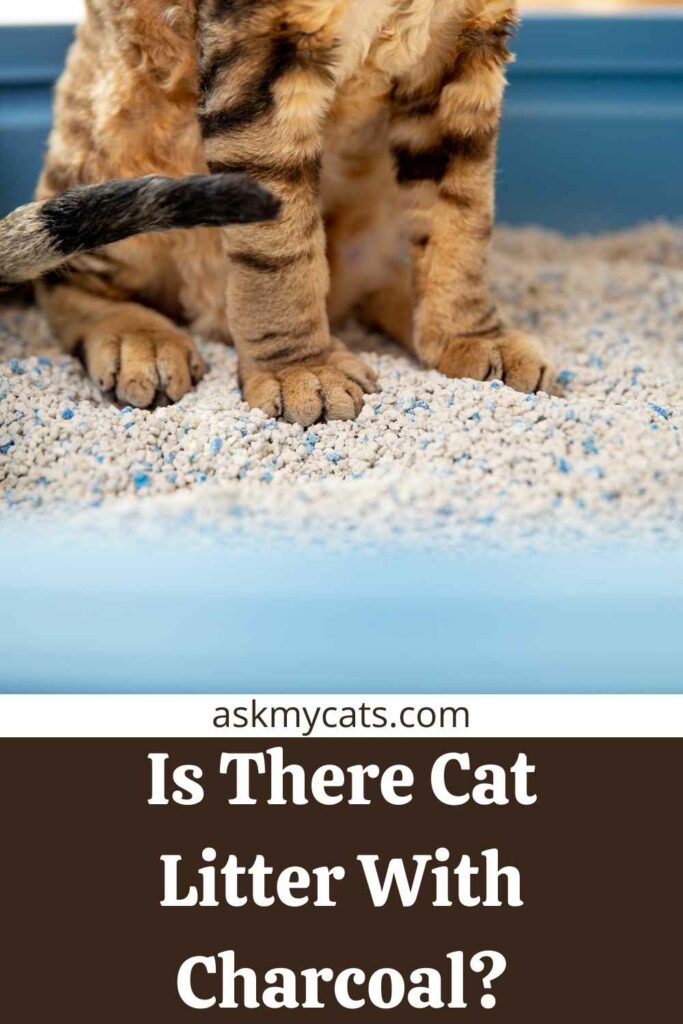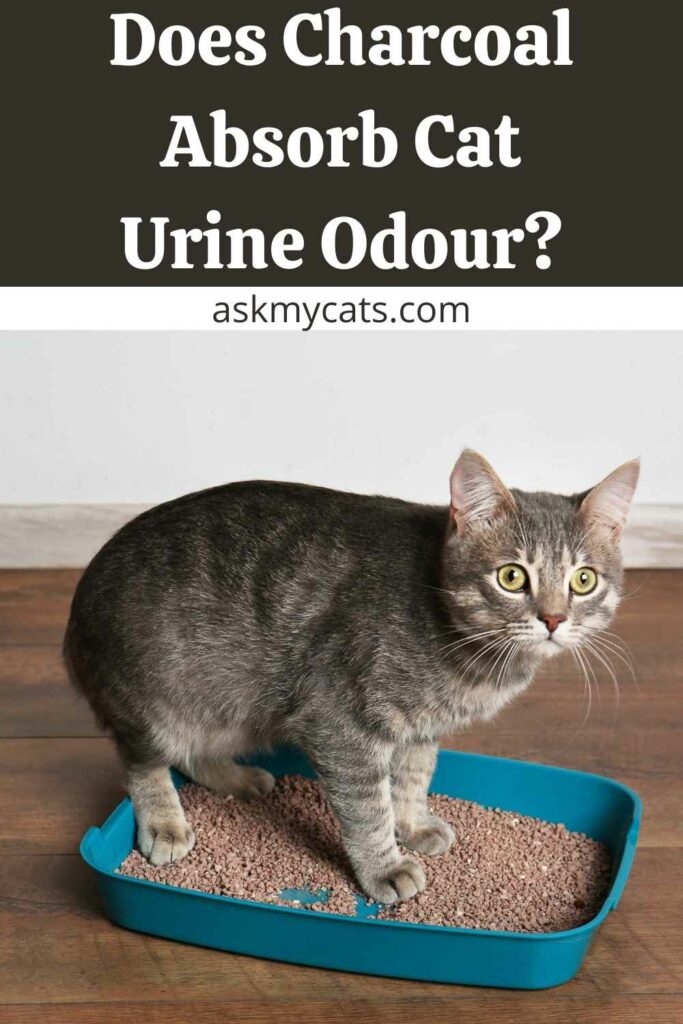You can choose to be adventurous in practically every aspect of your life, but messing about with the litter box can be disastrous. That’s why it’s critical to get the litter selection right the first time, which may be tough in a world where there are more sorts of litter than coffee brands.
When charcoal is mixed with regular clumping clay litter, it produces a litter that absorbs smells and liquids faster, but it also causes more dust and tracks.
While the specific chemicals that make it lightweight aren’t disclosed, activated charcoal is indicated as the main ingredient.


Give Your Cat the Perfect Day
Get the Free Ebook!
Is There Cat Litter With Charcoal?
Yes, charcoal can be found in cat litter.

The greatest result for tackling severe litter box scents is no fragrance at all. If you want to get rid of odours completely, use kitty litter that has been carefully prepared with activated charcoal. To explain how this incredibly absorbent, odor-eating ingredient works, we did some study.
Activated charcoal, often known as activated carbon, is a carbon-rich powder with micropores. It’s made by burning carbon-rich materials like coconut shells, wood, or coal to extremely high temperatures (1,110°F -1,650°F) and then collecting the leftover charcoal powder. Additional components have been added to activated charcoal to generate a broader, porous network.
Coconut shells are commonly used to make activated charcoal. Activated charcoal may also be made from bamboo and coal. Activated charcoal may be made in two methods. There are two types of activation: chemical and physical.
During the activation process, extremely minute surface pores, on the micro to nano scale, form around the charcoal fragments. Millions of these holes will develop, resulting in an increase in the charcoal’s surface area.
These activated charcoals now have microscopic holes surrounding them, which may absorb any odour from the surrounding environment. Because of the increasing active surface area, the absorbance characteristics of the pores will rapidly rise as they become micro to nano.
This phenomenon is commonly applied in nanotechnology. As a result, activated charcoal is a well-known industrial filter material for odour elimination, water filtration, and heavy metal trapping.
Activated charcoal has a technological edge over other odour elimination technologies due to the features listed above. The best aspect is that they are eco-friendly, safe, and affordable.
Charcoal’s fundamental building block is carbon. On the surface of charcoal, little microscopic holes (pores) are common. Gases, liquids, and even solids can be trapped in these holes.
Adsorption is the name for this process or phenomena.
The number of pores will considerably increase after the charcoal is activated. In addition, their size will shrink. One pound of activated charcoal is reported to have the surface area of 75 football fields.
As a result, activated charcoal possesses millions of odor-trapping pores that may react and efficiently capture a substantial amount of odor/smell.
Does Charcoal Absorb Cat Urine Odour?
Yes, charcoal greatly absorbs cat urine odour.

Activated charcoal is particularly absorbent since it is formed of porous carbon. Each charcoal particle has microscopic holes that draw molecularly smaller particles, gases, or liquids from the air and trap them inside. Activated charcoal of good quality may absorb up to 50% of its own weight, making it a valuable absorbent material.
A high concentration of organic gas, or vapour, which remains in the air, causes foul-smelling scents, such as those connected with your cat’s litter box.
Simply adding activated charcoal near the source of the stench is enough to start the absorption process. The odorous gas will be drawn from the air and trapped by the activated charcoal.
When you choose a cat litter that contains activated charcoal, you may easily eliminate odours from your cat’s litter box. Some odor-eating litters incorporate charcoal directly into the granules or pellets of the litter. Others incorporate charcoal into pre-made granules or pellets.
Alternatively, you may buy an odour remover with activated charcoal separately and mix it in with any cat litter.
What Kind Of Cat Litter Has Charcoal In It?

1. Fresh Step Light Weight Unscented
Fresh Step is a fantastic alternative for a household with many cats. Fresh Step’s low-tracking, low-dust, ultra-absorbent litter is made of clay and soaks up urine to create compact clumps that are simple to shovel.
The potent mix of additional Ammonia Blocker technology and activated charcoal eliminates odours. Fresh Scent will not only make cleaning easier for you, but it will also provide fresh air for you and your cat.
2. Tidy Cats Light Weight Free & Clean Unscented
Purina uses activated charcoal in this clay-based, clumping litter to combat strong litter box smells. An extra Ammonia Blocker helps to keep residual odours out of your house.
The low-tracking, low-dust proven recipe will not only keep litter inside the litter box for a cleaner house, but it will also allow you to simply clear away tightly clumped, dirty areas to leave unused litter pristine for your cat’s next visit.
3. Ever Clean Unscented Extra Strength
This clay-based, clumping litter’s name says it all. The extra-strength, odor-fighting solution not only incorporates activated charcoal into the litter, but also ties it to each individual granule.
Scoop-able, firmly clumped filthy regions are quickly removed using fast absorbing clay. Between cleanings, an antimicrobial agent maintains the litter box bacteria-free.
4. Fresh Step Advanced Unscented
Fresh Step’s strong Ammonia Blocking technology and activated charcoal combination are combined in this sophisticated formula litter to avoid smells for up to 10-days.
When scooping dirty areas from the litter box using this clumping, low-tracking, dust-free clay-based litter, there will be no odour. With this ultra-absorbent litter, surfaces and the air around the litter box stay cleaner for longer.
5. Prestige Pet Magic Odor Eliminator Additive
Add this all-natural odour remover to your cat’s litter box, regardless of the type of litter you use, to combat annoying scents.
Kittens and cats can safely utilise a non-toxic, dust-free, scent-free combination of odour absorbent materials (peat, coconut fibres, nutshell fibres, lignite, and activated charcoal). Add a few drops of Prestige Pet Magic (2 oz./week) to keep your litter box odor-free and increase the life of your litter.
6. Bolux Tofu Cat Litter Unscented
Bolux is a dust-free, low-tracking, flushable pellet litter created from 100 percent biodegradable material. Clump Lock technology adds soaking strength to already absorbent tofu, allowing for rapid clumping and scoopability.
Activated charcoal, which is odourless, absorbs undesirable smells. You and your cats will enjoy a litter box experience that is both fresh and environmentally friendly.
Do Charcoal Bags Work For Cat Litter?
Charcoal bags are fantastic at absorbing odors and bacteria inside a litter box.
Put roughly 300 to 500 grams of grilling charcoal in a dish, box, or bag, and store it in the cat litter. The charcoal will absorb smells in only a few hours. You should also clean your cat litter on a regular basis to keep the odour at bay.
Is Charcoal Litter Safe For Cats?
Yes, charcoal litter is safe for cats.
Is Activated Charcoal In Litter Safe For Cats?
Activated charcoal is an environmentally friendly substance. It does not include any potentially dangerous chemicals. As a result, your cat or kitten will be safe.
Activated charcoal is often made from coconut, bamboo, and coal. The qualities of activated charcoal might vary depending on the raw material used. So, for the greatest odour elimination, use activated charcoal made from coconut or bamboo.
Cat Litter With Charcoal Advantage
The advantage of using cat litter with charcoal is that it can instantly absorb the unpleasant smell coming from the litter boxes.
Even though powder activated charcoal has a larger surface area, handling it is a significant challenge. Charcoal powder may be found in almost every room of your home. Their black-colored dust can settle on every surface in your home.
Also, keep your activated charcoal-only items near your cat litter box while using them to reduce cat litter odour. Providing a means to expose the largest amount of surface area to the outer environment will also be effective.
Frequently Asked Questions
What are the benefits of carbon in litter?
Activated carbon in cat litter, unlike many other admixtures that claim to be effective at binding odours, actually works! The van der Waals forces bind odorous compounds to activated carbon physically. It acts in the same way as a magnet does: positive and negative charges are attracted to each other.
What cat litter is bad for cats?
Cats should avoid eating litter, but certain litter is more toxic than others. Sodium bentonite is found in clumping litter, and it is particularly harmful to cats. The sodium bentonite in their intestines might clump together and produce a blockage. When consumed, it can produce bentonite toxicities in extreme situations.
What is an alternative for cat litter?
While conventional clay litter is the most popular, there are less expensive alternatives for your cats. Wood pellets, maize, sand, sawdust, and even ripped up newspaper may all function well and are far less expensive than cat litter.
Final Words
Using cat litter with activated charcoal or a litter box with a carbon filter makes keeping an odourless litter box a lot simpler.
Activated charcoal is one of the most effective ways to get rid of cat litter odour. It is a non-toxic and ecologically safe approach. Furthermore, they are both safe and inexpensive to use for your cat. Their long-term benefits can drastically lower the amount of time you spend on your pet’s everyday responsibilities.
